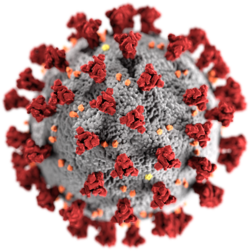Flagermusbårne virus


Flagermusbårne virus er virus, der hovedsageligt har flagermus som primære værter. Der er fundet virus i flagermuspopulationer rundt om i verden. Flagermus er i alle virusgrupper som angivet i Baltimore- klassifikationen, der deler virus i syv grupper efter deres arvemasse og replikationsmetode.[1] Virusgrupperne indbefatter coronavirus, hantavirus, lyssavirus, rabiesvirus, nipahvirus, lassavirus, henipavirus, ebolavirus og marburgvirus, der kan forårsage marburgfeber.
Flagermusbårne virus er den vigtigste gruppe af de virustyper, der betegnes som emergent virus,[2] opdukkende virus.[3][4][5]
Se også
Referencer
- ^ Om klassifikation af virus: "Virus classification – where do you draw the line?" Fra Nih.gov, US National Library of Medicine, National Institutes of Health
- ^ Om 'emergent virus' eller 'emerging virus':
- "Emerging infectious disease" (engelsk)
- Hvad er 'emerging infektuøs sygdom' fra Johns Hopkins: "What are emerging infectious diseases?" Arkiveret 4. juni 2020 hos Wayback Machine, Hopkinsmedicine.org ("... Emerging diseases include HIV infections, SARS, Lyme disease, Escherichia coli O157:H7 (E. coli), hantavirus, dengue fever, West Nile virus, and the Zika virus. ...")
- "Forskning i virusimmunitet" Arkiveret 10. august 2020 hos Wayback Machine fra Ssi.dk (Statens Seruminstitut) har udtrykket: "... men også andre, nye og ”emerging” virus fx ebola, usutu, zika mfl. ..."
- ^ Calisher, Charles H.; Childs, James E.; Field, Hume E.; Holmes, Kathryn V.; Schountz, Tony (juli 2006). "Bats: Important hosts of emerging viruses". Clin Microbiol Rev (engelsk). 19 (3): 531–545. doi:10.1128/CMR.00017-06. PMC 1539106. PMID 16847084.
{{cite journal}}:|access-date=kræver at|url=også er angivet (hjælp) - ^ Sumibcay, L; Kadjo, B; Gu, SH; Kang, HJ; Lim, BK; Cook, JA (2012). "Divergent lineage of a novel hantavirus in the banana pipistrelle (Neoromicia nanus) in Côte d'Ivoire". Virol Journal (engelsk). 9: 34. doi:10.1186/1743-422x-9-34. PMC 3331809. PMID 22281072.
{{cite journal}}:|access-date=kræver at|url=også er angivet (hjælp) - ^ Weiss, S; Witkowski, PT; Auste, B; Nowak, K; Weber, N; Fahr, J (2012). "Hantavirus in bat, Sierra Leone". Emerg Infect Dis (engelsk). 18: 159–161. doi:10.3201/eid1801.111026. PMC 3310113. PMID 22261176.
{{cite journal}}:|access-date=kræver at|url=også er angivet (hjælp)
Se også
- Virologi – Zoonose, smitte mellem dyr og mennesker
- Gruppe V i inddeling efter Baltimore klassifikationen af virus i syv grupper
Eksterne henvisninger
- "Vi kan ikke give flagermus skylden for corona-pandemien" Arkiveret 4. juni 2020 hos Wayback Machine fra Videnskab.dk, oversat fra The Conversation. Om den gavn flagermus er for mennesker. Af Peter Alagona, University of California, Santa Barbara, 11 april 2020
- Hayman, David T.S. (2016). "Bats as Viral Reservoirs". Annual Review of Virology. 3 (1): 77-99. doi:10.1146/annurev-virology-110615-042203. PMID 27578437.
- virus+flagermus Arkiveret 4. juni 2020 hos Wayback Machine hos Lex.dk
| Spire Denne artikel om biologi er en spire som bør udbygges. Du er velkommen til at hjælpe Wikipedia ved at udvide den. |
Medier brugt på denne side
Forfatter/Opretter: Emmanuel Boutet, Licens: CC BY-SA 2.5
A black bee (Apis mellifera mellifera.
This illustration, created at the Centers for Disease Control and Prevention (CDC), reveals ultrastructural morphology exhibited by coronaviruses. Note the spikes that adorn the outer surface of the virus, which impart the look of a corona surrounding the virion, when viewed electron microscopically. A novel coronavirus, named Severe Acute Respiratory Syndrome coronavirus 2 (SARS-CoV-2), was identified as the cause of an outbreak of respiratory illness first detected in Wuhan, China in 2019. The illness caused by this virus has been named coronavirus disease 2019 (COVID-19).
In order to comply with the use and licensing terms of this image, the following text must must be included with the image when published in any medium, failure to do so constitutes a violation of the licensing terms and copyright infringement: © Tomas Castelazo, www.tomascastelazo.com / Wikimedia Commons, CC BY-SA 4.0
Like bats out of hell, bats coming out of a cave for evening dinner in El Maviri, near Los Mochis, in the state of Sinaloa, Mexico.
Big eared townsend bat (Corynorhinus townsendii)
Forfatter/Opretter: Thomas Splettstoesser (www.scistyle.com), Licens: CC BY-SA 3.0
Virus, Baltimore Classification. Classes I-VII (Legend: ss = single stranded; ds = double stranded)






